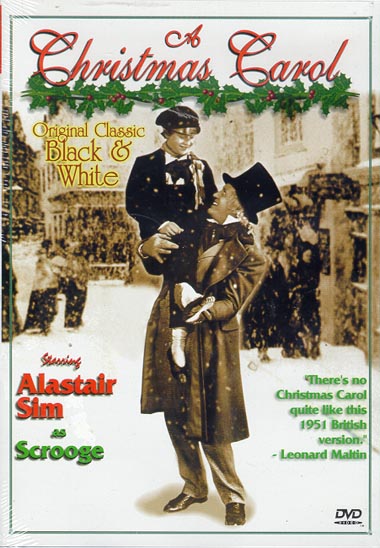By Steve Vivona
There have been countless retellings of the Charles Dickens classic, "A Christmas Carol," both on film and television. At last count there were at last ten versions (if you include "Mr. Magoo's Christmas Carol!") Many distinguished actors have taken a shot at the role including Reginald Owen, Frederic March, Albert Finney, George C. Scott, Bill Murray, Henry Winkler and Patrick Stewart. Some of them have missed the mark entirely and some have added new dimensions to this intriguing character, but it is the late Alastair Sim who took this role and made it his own.
In the 1951 version of "A Christmas Carol" (simply titled "Scrooge" when it was released) Sim played this role with all the appropriate malice, disgust and wickedness it required. Anyone who tries to soften the character waters him down and makes his conversion at the end much less wondrous than Dickens intended. Case in point: when Patrick Stewart essayed the role in his magnificent one-man show on Broadway I thought here is a man worthy to succeed Sim as THE preeminent Scrooge. However on film he chose to play Scrooge as cold rather than heartless, indifferent rather than spiteful, cheap rather than avaricious. It just doesn't work.
The only performance of Scrooge that comes near Alastair Sim is that of George C. Scott in the 1984 TV movie. Scott conveyed all the anger and rage of a man who resented the world and wanted no part of its celebrations, "warning all human sympathy to keep its distance!" His booming voice and stern demeanor made him a natural for the role, but it still falls short of Sim.
Why is Sim so brilliant in this role? Yes he is cruel, wicked and spiteful as the role demands, but it is his disdain and revulsion for everything Christmas stands for and the subtle ways in wish he shows it that make this performance the best. It's not how he berates or chastises but the incredulous disbelief he displays at the happiness of people like poor Bob Cratchitt or his nephew Fred.
Sim is also brilliant as he essays Scrooge's slow conversion as the three ghosts past, present and future, take him on a tour of himself and his ultimate destiny should no change occur. His deeply expressive face speaks volumes when confronted with the tragedies of his own life and that of Bob Cratchitt.
The icing on the cake is Scrooge's jubilation when he realizes he has a second chance at life. His elation is palpable, brilliantly comedic and truly poignant all at the same time. You can't help but feel happy at the sight of this man who realizes he has wasted his life and is ready to make amends.
Another reason this version is so successful is that it does not stray too far from the original text. The least successful versions either ignored important passages, made up some of their own, or dumbed-down the brilliant Victorian-era dialogue.
VCI/Magic Lantern has provided what will undoubtedly the best presentation of this film for years to come. Thankfully they have included the black and white version (as well as the awful colorized version). The quality of the source print is a bit soft, but it was an independent British production so it's to be expected. Patrick Macnee (who has a brief role in the film) is on hand to introduce the film. Also included is Max Flesicher's original "Rudolph the Red-Nosed Reindeer" cartoon which is a nice bonus.
|

